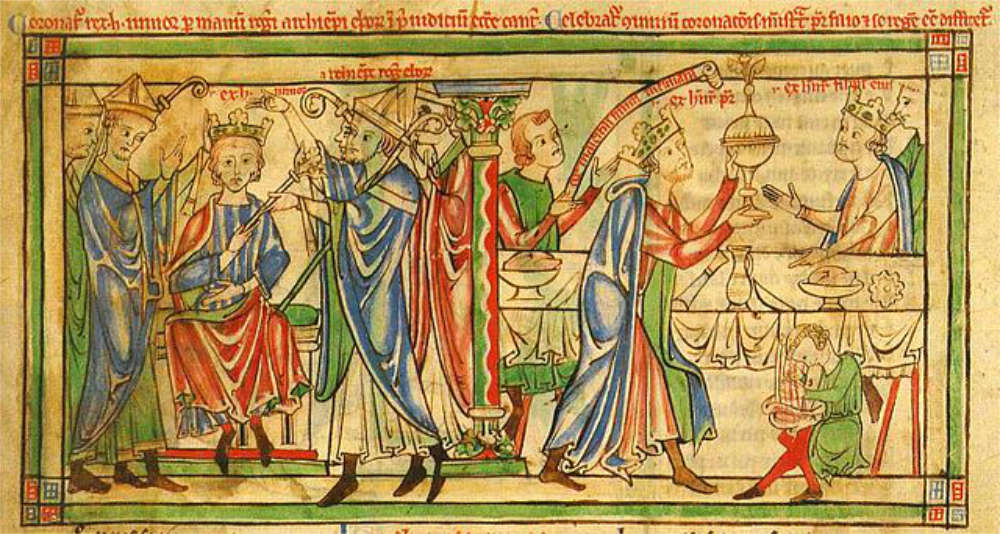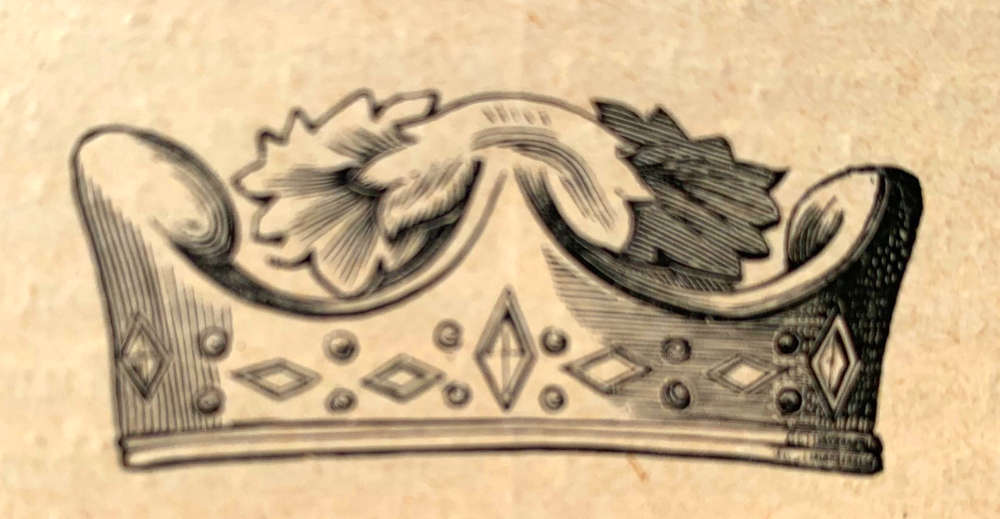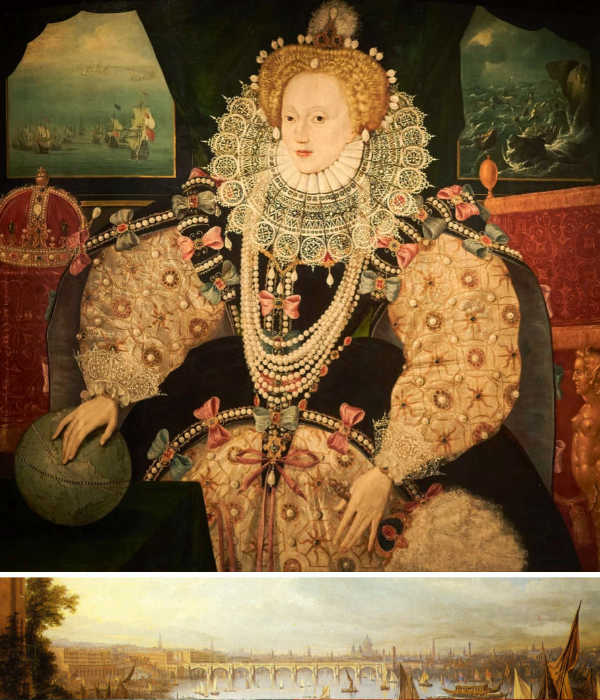To be glorious in both seasons
From the king to the Crown

One should serve [kings] not alone in preserving those dignities through which the glory of the royal majesty shines forth, but also in preserving the abundance of worldly wealth which pertains to them by reason of their station: for the former case a halo around them, the latter aid them. For indeed abundance of means, or the lack of them, exalts or humbles the power of princes. For those who lack them will be a prey to their enemies, to those who have them their enemies will fall a prey.
Richard FitzNigel; Dialogue of the Exchequer (c1175)
Royal wealth was not just for show, although that had its purposes too. Gather well and used wisely it provided security not just for the king himself but for the barons and people of his lands who depended on him. As the Norman Conquest showed all too well, successful invaders need have no respect for your family lands. And yet there was a trade. Wealth given up to a king was wealth that you didn’t get to enjoy yourself - you swapped some additional grandeur to secure what you already had. But security came in other ways too. In a world of rights, claims and counter-claims, decisions going against you or the capricious whim of your own lord could wipe you out just as surely as an invading army. Good lordship, coupled with how much it was worth, became the issue of the age.
England in the twelfth century had almost every type of lordship on show. Local lords held their own manorial courts, the old Anglo Saxon shire and hundred courts persisted for a time, church courts had operated since the 1070s, while around one third of the kingdom fell under forest law. Above it all sat the king’s court, presided over by the king himself or his justiciar. Looking beyond, many lords would either have had continental lands or experienced how somewhere like Normandy or Anjou operated. Alternatives were on show. Kings feared that rival claimants to the crown could pick up support with the promise of a better way of going about their business.
Not that it is immediately obvious what was preferred. Henry I certainly provided security and reunited England and Normandy, although for his subjects this may have seemed costly since he died with his treasury full to bursting. Worries instead came from domestic politics and the fear that lands and opportunities were being lost to Henry’s ’new men’ who he ’raised up from the dust.’ These new men often rose up through royal service, which increasingly included the king’s administration. Sheriffs and local landholders competed for power and influence, along with the income that went with it.
If Henry I was too strong, Stephen proved too weak for some, especially the church. The collapse of his authority saw barons run riot in much of the kingdom during the 1140s, imposing their power over that of the king and the rights of neighbours who could not stand up to the likes of Geoffrey de Mandeville and others as they gathered in lands and threw up castles to keep hold of them. A baronial free-for-all was only to the taste of those barons who did well out of it. It was certainly not desirable to the king, and was almost certainly a raw deal for those people - including knights and lesser lords - who relied on these great barons for justice themselves. Too strong or too weak. The Goldilocks solution was yet to be found.
For Henry, the first step was to restore his own rights. Gerald of Wales sets the scene, nicely summing up Henry’s immediate problem. There is a second half to this quote, though, which we will come to, and which neatly explains the long term problems that resulted.
By the time of Henry II so much land had been granted from the royal demesne that income from it, paid to the king by his sheriffs, amounted to barely £8,000 a year…
Gerald of Wales (c1190)
The new king set about recovering royal lands that had been alienated in the 1140s. This must have only been partially successful as Henry’s time in England during the mid-1160s saw a much more focused effort. At the Council of Winchester in 1163 he tried to have the 2 shilling per hide Sheriff’s Aid made payable directly to the king, presumably to stop so much of it sticking to the sides along the way, until Becket scuppered it for reasons not fully understood either then or now. The theme continued in 1166 with the Cartae Baronum. Something of a refreshment of Domesday Book, the Cartae Baronum reviewed the knight’s fees due on each estate. Each lord was obliged to provide a number of knights when required, although it had become normal to commute this to scutage, a cash equivalent set by the king. Lords paid scutage based on the documented number of knights they owed. It was common practice - by all, up to and including the Archbishop of Canterbury - to game the system, enfeoffing more knights than their quota. When the king raised scutage, lords paid based on their quota but gathered from all of their knights and pocketed the difference. If the old arrangements seemed unfair to the knights, the solution may have made them feel better but saved them no money. It was a statement of royal principle.
If Henry hoped to root out this kind of sharp practice, things seem not to have gone entirely to plan. Returning for a short visit to England in 1170, Henry launched the Inquest of the Sheriffs to find out what was going on. In reality this was an inquest into far, far more:
Archbishops, bishops, abbots, earls, barons, sub-tenants, knights, citizens and burgesses, their stewards and servants, as to what and how much they have received since the king’s last departure from their lands, from each hundred and village and from each of their men, by a judgement or without judgement; and let the justices write down all of these exactions and their courses and occasions.
Henry II, launching the Inquest of the Sheriffs (1170)
What starts as a review of how his sheriffs delivered the Assize of Clarendon and managed their financial activities extended to cover how royal lands are managed and maintained, as well as the feudal taxes collected in 1168 on the occasion of Henry’s daughter’s marriage to Henry the Lion, duke of Saxony. We have seen what the English administrators could do with Domesday Book, but this was something else altogether; to Gervase of Canterbury it was an inquisitio mirabilis.
For a king of France or a king of Germany to have contemplated such an enquiry would have been unthinkable
W L Warren, Henry II (2000)
Warren continues: ’It might be thought that the king was asking the impossible, were it not that fragments of the returns survive.’ He picks out some choice examples, a couple of which show the extent of what was involved. ’Fifteen days before the Purification of the Virgin next following, it will be four years since the servants of the earl of Arundel seized four hundred and five sheep belonging to Matthew of Candes and drove them as far as Snettisham and kept them fourteen weeks. On the journey two died. They had in their charge eighteen ewes and eighty lambs: and a sum of two shillings was paid over to these servants. In fact nothing was due to the earl. The earl’s bailiffs say in justification that they seized the aforesaid chattels for default of service by Anelald of Bidon. The earl himself admits of what was done and complains of Anelald…’
For a certain scutage the earl of Clare had thirty shillings, and again a second time a further thirty shillings; and for the said moneys the earl’s servants seized a certain horse. But although they have received the moneys they still retain the horse…
Return from Inquest of the Sheriffs (1170), quoted in W L Warren, Henry II (2000)
The institutional memory needed to put this together is incredible.
Henry, to his mind at least, had set the rules and expected them to be applied. Clarity and consistency are no doubt features of effective lordship. The extent of the invasiveness and scrutiny - the reach of royal government - may have been a rude awakening.
Perhaps it should not have done. Henry had focused on England’s law during his stay between 1163 and 1166 and, in return for that bit more clarity, had ensured that the king would remain in charge of the kingdom’s justice, including between his barons and their vassals.
England had a good basis of legal precedent. The Anglo Saxon law codes built towards the often cited Laws of Edward the Confessor, that were further build on by the two Williams and Henry I. Henry I’s Coronation Charter provides the main link between old and new, but Henry I made real advancements such as regular judicial eyres - circuits to bring royal law to the localities. If much of this practice disappeared under Stephen, the memory of it did not.
Henry II’s first steps came with the Constitutions of Clarendon in 1164. Caught up in the first flourish of Becket’s independence from Henry, it still established the king’s court as the final court of appeal, and placed advowson and presentment disputes under royal supervision. His efforts to bring criminous clerks under royal auspices as well became a much longer story.
The Assize of Clarendon followed in 1166, which set up the Jury of Presentment. ’Enquiry shall be made into every county and every hundred through twelve of the more law abiding men of each hundred and through four of the more law abiding men of each vill, put on oath to tell the truth, whether there is in their hundred or vill any man accused or publicly suspected as robber or murderer or thief or anyone who has harboured them since the lord king became king.' This was intended as a temporary measure, but became part of the law from the Assize of Northampton in 1176. For a short term fix its record was remarkable. It survived as the grand jury until the establishment of the office of the Director of Public Prosecutions in 1879. In the US - that other long term beneficiary of Henry’s reforms - the grand jury is still alive and well.
At a time when both the church and continental powers were moving towards a more arbitrary, ex officio, approach to prosecution that to nineteenth century historians such as Maitland was ’inquisitorial’ and creating an authoritarian bias, England moved away from it. A continental baron would have been appalled at the through that ’no-one shall have jurisdiction or judgement or forfeiture except for the lord king in the royal court, or that a royal official - the sheriff - now had the right to go onto a lord’s lands to enforce rights. The king had inserted himself between a lord and their own vassal. A help, perhaps, to those sub-tenants as they were now not subject only to their local lord. Less comfort, however, to those tenants-in-chief who still had to deal direct with the king.
If the mid-1160s saw the great leap forward, the law was revisited and firmed up with the Assize of Northampton in 1176. Justices were added to the royal arsenal over the heads of the sheriffs. Specific processes for issues such as Novel Disseisin - where one man was dispossessed by another - and Mort d’Ancestor - inheritance disputes - were brought in based on writs and the use of juries of presentment in front of justices. Something like Mort d’Ancestor was open to small and large landholders alike to work through the king’s courts.
For Henry there was much to recommend this. Widening the use of royal courts brought his lordship directly to those further down the feudal structure. It brought him an improved income as all of this justice can at a price. He could also offer more patronage with justices and a near-permanent court at Westminster, which became the Court of Common Pleas.
For those who relied on justice - and who could afford it - there were now more options, fewer delays and less reliance on a baronial whim. For the barons themselves, though, the power and profits of justice were starting to ebb away. Making the process more systematic had also made it more severe, with less room for favour and leeway.

Surly, though, this was improvement. The Leges Henrici Primi look rudimentary compared to Ranulf Glannvill’s Laws and Customs of England and Richard FitzNigel’s Dialogue of the Exchequer, which are both superb, detailed and practical handbooks. We know that royal government was capable of impressive things, but now that effectiveness was refined and deployed by to the benefit of the king. Were that the whole story, the great leap forward would have been made. But we now need to get back to Gerald of Wales where he left off:
So how come King Henry and his sons had abundant wealth despite their many wars? The reason is that they had added to their revenue by resorting to ‘casual’ or ‘extraordinary’ sources of income.
Gerald of Wales (c1190)
The proceeds of justice were one of these. We have seen how common law expanded Henry’s options, but he was fully unbound elsewhere. In nearly one third of the kingdom, common law did not apply; it was the law of the Forest. In the Dialogue of the Exchequer, Richard FitzNigel gives us the official version: ’the whole organisation of the forests, for example the punishment of forest offenses, is outside the jurisdiction of other courts, and solely dependent upon the decision of the king and his officers. The Forest has it own laws, based, it is said, not on the common law of the realm but on the arbitrary decision of the king’
The worst abuse in the kingdom, under which the country groaned, was the tyranny of the foresters; for there violence took the place of law and extortion was peaceworthy. No rank of society was secure from them save the king himself.
Biographer of St Hugh of Lincoln
As an idea of scale, the Forest covered the whole of the county of Essex and much of Berkshire, Hampshire and Wiltshire. It could be designated at will and Henry famously loved the chase. Forests were not just a royal plaything, however, as they gave the king protected access to key supplies such as charcoal, which was used for smelting in the manufacture of armour and weapons. Restrictions were stringent, with limits on everything from cutting wood to the length of a dog’s claws. Exemptions and licenses could, of course, be had for a price.
The royal will could also raise money directly. As feudal lord, Henry could raise taxes and fines. His son’s knighting, the marriage of his daughters, and his barons’ own inheritance were worthy occasions for an aid to be levied. Henry II, like his grandfather, kept rates arbitrary. If barons tried to pass the cost down to their tenants, as they had with knight’s fees, Henry II was canny in pulling the revenues all the way up to his own treasury. In return, he fixed rates for those further down the social order, for example on a knight’s inheritance. Yet:
For baronies there is no certain figure laid down; the tenants-in-chief in making satisfaction to the lord king for their reliefs are at his mercy and pleasure.
Ranulf Glannvill; Laws and Customs of England (between 1187 and 1189)
Royal favour was still available, as Henry II could compromise on the cash amount of what was owed. The balance was, inevitably, left outstanding, and Richard FitzNigel explains in the Dialogue of the Exchequer just how difficult it is to be truly quit of a debt rather than simply in deferral. A helping hand to a baron’s loyalty, perhaps, but at the same time a lingering threat of what could be ruin at any given moment, depending on how it was used.
Barons, though, might reasonably have felt squeezed between the lord king and their own tenants, and with fewer protections. They were not free to make their own laws in their lands, nor could they appeal over the head of their immediate lord.
It is here, and in the depths of the forest, where we can unravel the apparent contradiction that the Angevin despotism also gave the foundations - and much more besides - of Common Law to the English speaking world. These were different jurisdictions, defined by both place and right. So to Henry II it was likely no contradiction at all.
Common Law, such that it had emerged, set an example. A precedent. Whether the rest of the system could be redeemed, either through force or benign neglect, would depend on the nature of the king. For all the institutional advances, that one role was critical and utterly indispensable.
In the middle ages, in some cases the date of Richard I’s coronation, 3 September 1189, was taken as the limit of legal memory. When Edward I’s Quo Warranto investigation looked back, that was deemed far enough. It was the end of the beginning. In the eyes of the law, modernity had arrived.
Bibliography
- Warren, W.L. (2000) Henry II. London, Yale
- Poole, A.L. (1955) From Domesday Book to Magna Carta. Oxford, Oxford University Press
- Ranulf Glannvill (late twelfth century) The Laws and Customs of England
- Richard FitzNigel (late twelfth century) Dialogue of the Exchequer
- Brooke, C. (1966) From Alfred to Henry III. London, W.W. Norton & Company, London
- Clanchy, M.T. (1983) England and its Rulers. London, Fontana


